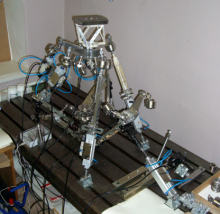Jet and cavitation devices forimprovement of energy efficient mechatronic systems in machinebuilding

Іn this paper a new approach to the basic parameters choice of controlled spherical liquid friction supports spatial mechanisms using the Monte Carlo method is developed. A jet system adjusts the position of the sphere by changing the hydrodynamic resistance to flow at the exit slit hydrostatic, or combined balloon aerohydrostatic spherical bearings.
The regulation realizes by near wall liquid on gas jets, formed in peripherical cracks pinpoint nozzle with curved channels combined in a special collector system with spatial curved hydraulic communication and branching. Based on theoretical developments and complex experimental research formulated a set of input data for the design of fluid frictional spherical supports spatial arrangements of jet adjustable position field. Carried out the scientific rationale for the choice of geometrical and operational parameters of support, the requirements to manufacturing technology, recommendations for regulations and support the development of mechatronic control systems and the software for programmable controllers.
The technical is developed documentation and a number controlled spherical supports options fluid friction. As a result of the development recommendations for the design of spherical supports fluid friction for spatial mechanisms. The a number of practical conclusions installation features, static, and dynamic characteristics are proposed of controlled spherical supports fluid friction were formulated. Based on the mathematical model and analytical research the developments are conducted by the features of the emergence and existence of cavitations zones when using tube cavitations device, excited at zero mode fluctuations.
The adequacy of the results is confirmed by experimental results. The method of engineering calculation tube flow cavitations chamber, which ensures their high intensity and longevity by creating zones with a minimum intensity of cavitation on the radiating surface of the tubular cavitations and zones of maximum cavitations intensity in the focal cavitations device area.
According to the theoretical and experimental results clarified the possibility of high concentrations of ultrasound in liquids, while ensuring the durability of the radiating surface and the reasons for their limitations.
The analysis of results sets out the basic requirements for the ultrasonic cavitations equipment for handling liquids and shows how to realize it. The high efficiency of the ultrasonic cavitation equipment is showed on the example the disintegration process and of microorganisms inactivation in liquid media.
| Долучення | Розмір |
|---|---|
| 386.5 КБ |




